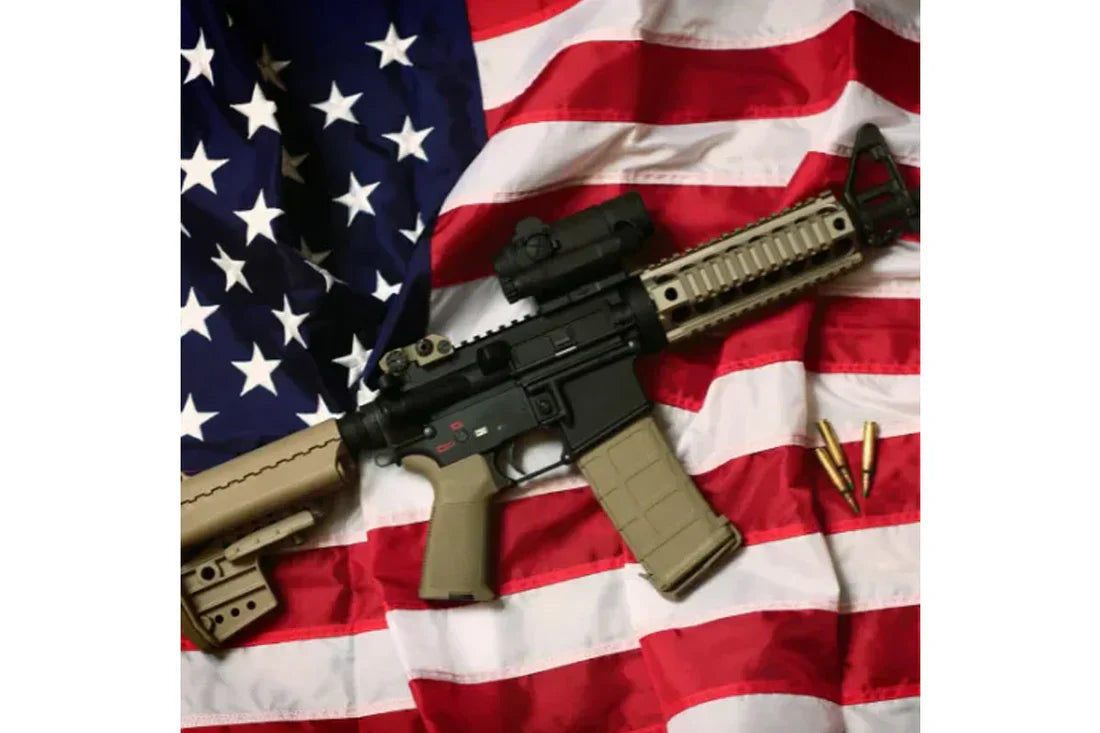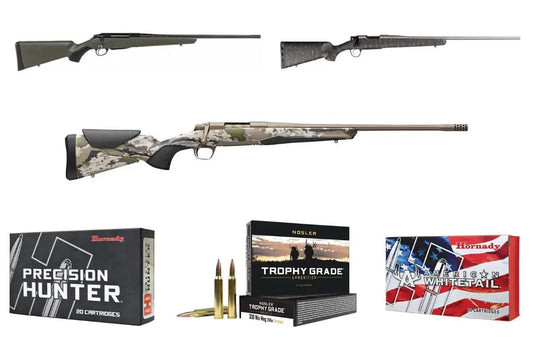
From Space-Age Prototype to “America’s Rifle”: The Definitive History of the AR-15
TL;DR for Skimmers
The AR-15 began as Eugene Stoner’s lightweight, aerospace-inspired rifle at ArmaLite, was industrialized by Colt, and matured through Vietnam’s hard lessons into today’s ultra-modular platform. Standards like Picatinny and M-LOK (validated by NSWC Crane) plus mid-length gas and free-float tubes define the modern rifle. If you want top-tier examples, start with KAC SR-15 E3, Daniel Defense DDM4 V7, BCM RECCE-16, or LMT MARS-L, and pair with Aimpoint PRO, ACOG/ATACR/Razor LPVO, and a Geissele two-stage trigger. For calibers, .300 BLK (short/suppressed) and 6.5 Grendel (reach) extend the platform’s horizon.
|
Era |
Key Moment |
Why It Mattered |
Representative Product |
|
1950s |
Eugene Stoner’s lightweight, aluminum-and-polymer rifle at ArmaLite |
Introduced the “internal gas piston” concept and a radically light infantry rifle |
ArmaLite AR-15 (pre-Colt) |
|
1959–1964 |
Sale of AR-15 rights to Colt; USAF interest; military adoption as M16 |
Industrialized production; paved the way for U.S. service rifle lineage |
Colt SP1 (civilian launch, 1964) |
|
Late 1960s |
Early Vietnam reliability crisis and fixes |
Chrome lining, ammo changes, and training corrected teething troubles |
Army “M16 Review Panel” report (1968) |
|
1994–2004 |
Federal Assault Weapons Ban (AWB) |
Drove “post-ban” feature sets and market innovation; sunset in 2004 |
AWB provisions & timeline |
|
2010s |
Free-float rails, mid-length gas, M-LOK, and piston variants mature |
Modern performance leap; SOCOM picks M-LOK; URG-I fielded |
NSWC Crane report; M-LOK history; URG-I background |
|
Today |
The modular, multi-caliber ecosystem |
AR-15 is a platform more than a rifle: duty, competition, and hunting builds |
Top-tier factory carbines (KAC, DD, BCM, LMT) |
Few firearms have inspired as much engineering, enthusiasm, and controversy as the AR-15. What began as a moon-shot prototype from a California skunkworks has become the most influential rifle platform in the United States—an endlessly configurable “system” that underpins duty carbines, precision rigs, PCCs, suppressor-ready SBRs, and hunting rifles. Let’s trace how we got here, what changed along the way, and why it matters for shooters today.
Origins: Stoner’s Lightweight Vision (1950s)
In the mid-1950s, Eugene Stoner at ArmaLite set out to build a lighter, softer-shooting infantry rifle using aerospace materials (forged aluminum receivers, composite furniture) and a slim, high-velocity cartridge. His operating system—often mislabeled “direct impingement”—channels gas through a tube into the bolt carrier, where the carrier acts as a cylinder and the bolt as the piston. It’s more accurate to call it an internal gas piston system. The result: fewer reciprocating parts on the barrel, excellent barrel harmonics, and a lighter front end.
ArmaLite’s scaled-down AR-15 sprang from the earlier AR-10 and proved that a 5.56-caliber, lightweight rifle could be controllable and fast. Stoner later quipped about his career, “It was kind of a hobby that got out of hand.” –The New Yorker
Colt, the USAF, and the M16 (1959–1960s)
ArmaLite lacked the manufacturing capacity to take the AR-15 mainstream, so Colt bought the design and trademark in 1959, refined it for production, and aggressively marketed it. After a demonstration impressed Gen. Curtis LeMay, the USAF placed an early order; by 1964 the U.S. military adopted the design as the M16. Colt simultaneously launched the semi-auto Colt SP1 for the commercial market—arguably the first iconic “modern sporting rifle.”
Vietnam’s Hard Lessons
Early M16 fielding suffered from a perfect storm: ammo propellant changes, lack of chrome lining and cleaning kits, and misleading “self-cleaning” lore. The 1967–68 Army reviews and congressional scrutiny forced fixes—chrome-lined bores/chambers, training, and proper maintenance—stabilizing the platform and paving the way for the M16A1 and beyond. –TheColtAR15Resource.com
The Civilian AR-15 Blossoms (1970s–1990s)
Throughout the 1970s–80s, Colt’s SP1 and successors trickled into civilian hands. Civilian barrels evolved from the original 1:12 twist (.223/55gr) to 1:7–1:9 twists for 5.56 NATO loads, and the aftermarket began its long rise. By 1994, the Federal Assault Weapons Ban restricted features (flash hiders, collapsible stocks, bayonet lugs, etc.) on new production; manufacturers responded with “post-ban” configurations. The AWB expired in 2004, unleashing a golden era of innovation.
Rails, Gas Lengths, and the Modern Accessory Era (2000s–2010s)
Two structural changes shifted how ARs were built and used:
-
Attachment standards
MIL-STD-1913 Picatinny rails (formally standardized in the 1990s) made optics and accessories bolt-on universal. Then M-LOK arrived (2014), bringing lighter, thinner free-float handguards with direct accessory mounting. NSWC Crane testing for USSOCOM concluded “M-LOK is a more robust and more stable system” versus KeyMod, in repeatability and drop/failure tests—cementing M-LOK as the current standard. -
Gas system tuning
Carbine-gas 16-inch rifles worked, but mid-length gas became the connoisseur’s choice for lower port pressure and smoother cycling—especially with free-float tubes and suppressors. The shift shows up in flagship rifles like Daniel Defense’s DDM4 V7 (16", mid-length, M-LOK).
The Piston Counterpoint
While Stoner’s internal-piston system remains dominant, short-stroke piston variants such as the HK416 have thrived, particularly in harsh, high-volume or suppressed use. The USMC’s M27 IAR—an HK416 derivative—progressed from an automatic rifle concept to broad infantry issue, illustrating the piston path inside an AR-pattern architecture.
Beyond 5.56: The AR-15 as Multi-Caliber Platform
The AR’s two-receiver architecture makes caliber swaps trivial. Two milestones:
- .300 AAC Blackout (2011 SAAMI): optimized for short barrels and suppression, uses standard 5.56 bolts/mags (capacity preserved) with only a barrel change. It unlocked quiet, subsonic capability with full-mass bullets while retaining carbine ergonomics.
- 6.5 Grendel (SAAMI 2010): a long-range, efficient 6.5mm in the AR-15 envelope, trading some mag capacity for superior external ballistics past 500 yards.
The Modern Benchmark: What “Good” Looks Like Today
If you want a single picture of where six decades of iteration ended up, look at these no-compromise, duty-grade exemplars:
- Knight’s Armament SR-15 E3 Mod 2 — KAC’s proprietary E3 bolt (enhanced lug geometry), hammer-forged 1:7" barrels, full ambi lower, and refined reliability make this many professionals’ “if I could have one AR” pick. KAC describes the E3 bolt as designed for “safety and long bolt life”—an ethos you feel on the line. –KnightArmco.com
- Daniel Defense DDM4 V7 — A reference 16" mid-length with a cold-hammer-forged barrel and lightweight M-LOK handguard. DD explicitly calls out smoother cycling and reduced parts wear with mid-length gas, which you notice in recoil impulse and dot movement.
- BCM RECCE-16 MCMR — Bravo Company’s reputation for hard-use uppers, attention to gas drive, and correctly spec’d small parts makes the RECCE-16 a superb “workhorse” carbine, consistently praised for reliability.
- LMT MARS-L / Defender-L — Fully ambidextrous controls and the LMT monolithic upper (MRP) give bomb-proof rigidity and easy barrel swaps—a favorite among agencies and clone-builders.
Optics & fire control that match the rifle:
- Aimpoint PRO (2 MOA): a duty-grade, always-on red dot with monstrous battery life and QRP2 mount—arguably the best value for a serious carbine.
- Trijicon ACOG TA31 (4× fixed): still relevant for rugged simplicity, battery-free illumination, and proven BDC reticles.
- Nightforce ATACR 1-8×24 F1 (LPVO): bomb-proof glass with daylight-bright center; chosen for SOCOM programs and beloved by hard-use shooters.
- Vortex Razor HD Gen III 1-10×: the modern “do-all” LPVO, giving you red-dot speed at 1× and real reach at 10× in an AR-friendly package.
- Geissele SSA-E / SSA / SD-C triggers: crisp, reliable two-stage options trusted from duty to DMR builds (typical pull ~2.9–3.8 lb on SSA-E).
Anatomy of Modularity
What made the AR-15 explode into an ecosystem is not just parts availability—it’s architecture:
- Two-pin upper/lower: swap barrels, calibers, and gas systems without touching the serialized lower.
- Magazine standardization: the STANAG pattern established a shared ecosystem across platforms.
- Attachment standards: Picatinny first, then M-LOK—lighter, stiffer handguards with rock-solid accessory repeatability (per Crane).
Culture, Law, Controversy
The AR-15 is both beloved and contested, regularly referenced in policy debates and media cycles. The 1994–2004 AWB shaped design language for a decade; in 2019, Colt briefly paused civilian AR-15 production citing market saturation before later resuming shipments. These currents reflect a rifle that’s transcended “product” to become a cultural symbol.
Expert note (SOCOM testing): NSWC Crane’s 2017 study recommended M-LOK over KeyMod because it maintained point-of-aim repeatability better and withstood impacts—one of the few times a government lab has publicly picked an accessory standard.
Mini-Timeline: The AR-15’s Greatest Hits
- 1956–59: ArmaLite AR-15 prototyped; Colt buys rights and trademark (1959).
- 1960–64: USAF interest (LeMay); U.S. adoption as M16; Colt SP1 launches for civilians (1964).
- Late 1960s: Reliability crisis → fixes (chrome, ammo, training).
- 1994–2004: AWB shapes features; sunsets in 2004.
- 2011: .300 AAC Blackout standardized by SAAMI—suppressed SBR heaven.
- 2014–17: M-LOK released; Crane testing crowns it over KeyMod (SOCOM adoption follows).
- 2018+: URG-I (Geissele MK16 rail, mid-length gas) enters U.S. SOF service; the silhouette of the M4 quietly modernizes.
“Best in Class” AR-15s You Can Actually Buy (Opinionated Shortlist)
If you prioritize meticulous design and top-shelf execution, start here:
- Knights Armament SR-15 E3 Mod 2 M-LOK — multi-lug E3 bolt, hammer-forged barrel, full ambi, tuned gas. Expensive, but the closest thing to a “no-excuses” do-everything carbine.
- Daniel Defense DDM4 V7 / V7 SLW — mid-length gas, free-float M-LOK, CHF barrels; the SLW trims weight without going fragile.
- BCM RECCE-16 MCMR — thoughtful gas porting, quality BCGs, and excellent uppers; the quiet professional’s pick.
- LMT MARS-L / Defender-L 5.56 — true ambi lower, monolithic upper rigidity, and quick-change barrel capability; built like a brick.
Pro accessories (duty-grade, not trinkets):
Aimpoint PRO for a rugged dot; Trijicon ACOG TA31 if fixed 4× suits your mission; Nightforce ATACR 1-8× or Vortex Razor Gen III 1-10× if an LPVO fits your AO; Geissele SSA-E/SSA/SD-C for predictable, repeatable two-stage pulls.
Pros & Cons of the AR-15 Platform (Be Critical)
Pros
- Modularity & ecosystem: unmatched parts availability, from barrels to triggers to optics; a real “platform,” not a single rifle.
- Accuracy per pound: free-float handguards and the internal-piston carrier lend excellent barrel harmonics and manageable recoil.
- Ergonomics: inline recoil path, straight stock, and modern controls (ambi lowers on premium guns) speed up learning and reduce shooter fatigue.
- Attachment standards that work: M-LOK proven in government testing to hold POA/POI through mounts, remounts, and drops.
Cons
- Gas in the action (and face, when suppressed): Stoner’s system dumps heat/fouling into the carrier—fine when tuned and maintained, but more sensitive to gas, lube, and suppressor back-pressure than some piston rifles.
- Quality variance: not all ARs are created equal; sub-spec parts and out-of-tune gas can sour reliability. (This is why the picks above exist.)
- Legal patchwork & optics of ownership: feature bans and political currents periodically roil the market; understand your local laws.
Quotable Wisdom
- Eugene Stoner on his career: “It was kind of a hobby that got out of hand.” –The New Yorker
- NSWC Crane (SOCOM testing): “M-LOK is a more robust and more stable system.” –Soldier Systems Daily
- USMC Program Office (M27): additional M27 IARs would “partially replace the current M4 carbine”—a telling shift in how a piston AR-pattern can fill multiple roles. –marcorsyscom.marines.mil
- L. James Sullivan (AR-15 co-designer): “Barrel heat comes from bullet friction, not gas temperature…”—a designer’s reminder that systems engineering beats superstition. –SmallArmsReview.com
Where We Are Now—and What’s Next
Today’s AR-15 is less a “gun” than a framework—a solved problem that keeps getting refined at the edges: better coatings and bolt geometry (KAC E3), cleaner gas (adjustable blocks and well-sized ports), stiffer/lighter rails (M-LOK with proper anti-rotation), and optics that let you see more, sooner. USASOC’s URG-I—with a mid-length gas system, a free-float Geissele MK16 rail, and M-LOK—might be the quiet apex of the classic pattern in hard service.
On the caliber front, .300 BLK remains the king of suppression and short barrels, while 6.5 Grendel and similar 6mm/6.5mm options satisfy shooters chasing wind efficiency in the AR-15 footprint. Expect incremental gains, not revolutions—think better gas, better metallurgy, smarter suppressor integration, and even lighter, stiffer handguards.
Quick Buyer’s Guide: “If it were my money…”
- General-purpose carbine: KAC SR-15 E3 Mod 2 — spend once, cry once.
- Lighter 16″ do-all: Daniel Defense DDM4 V7 (or SLW) — smooth mid-length, CHF barrel.
- Hard-use, high value: BCM RECCE-16 MCMR — excellent gas tuning and QC.
- Ambi + monolithic nerd joy: LMT MARS-L/Defender-L — rock-solid and future-proof.
- Optics: Aimpoint PRO (dot), Trijicon ACOG TA31 (fixed), Nightforce ATACR 1-8 or Vortex Razor Gen III 1-10 (LPVO).
- Trigger: Geissele SSA-E / SSA / SD-C — predictable, durable two-stage.
Safety & compliance (non-obvious but crucial): Verify your local/state feature laws (stocks, muzzle devices, OAL, barrel length), NFA rules for SBRs/suppressors, and magazine restrictions before buying. The regulatory patchwork changes the “best build” calculus more than any spec sheet.
Shop a wide variety of AR-15 rifles, parts, and ammo → Brownells.com



